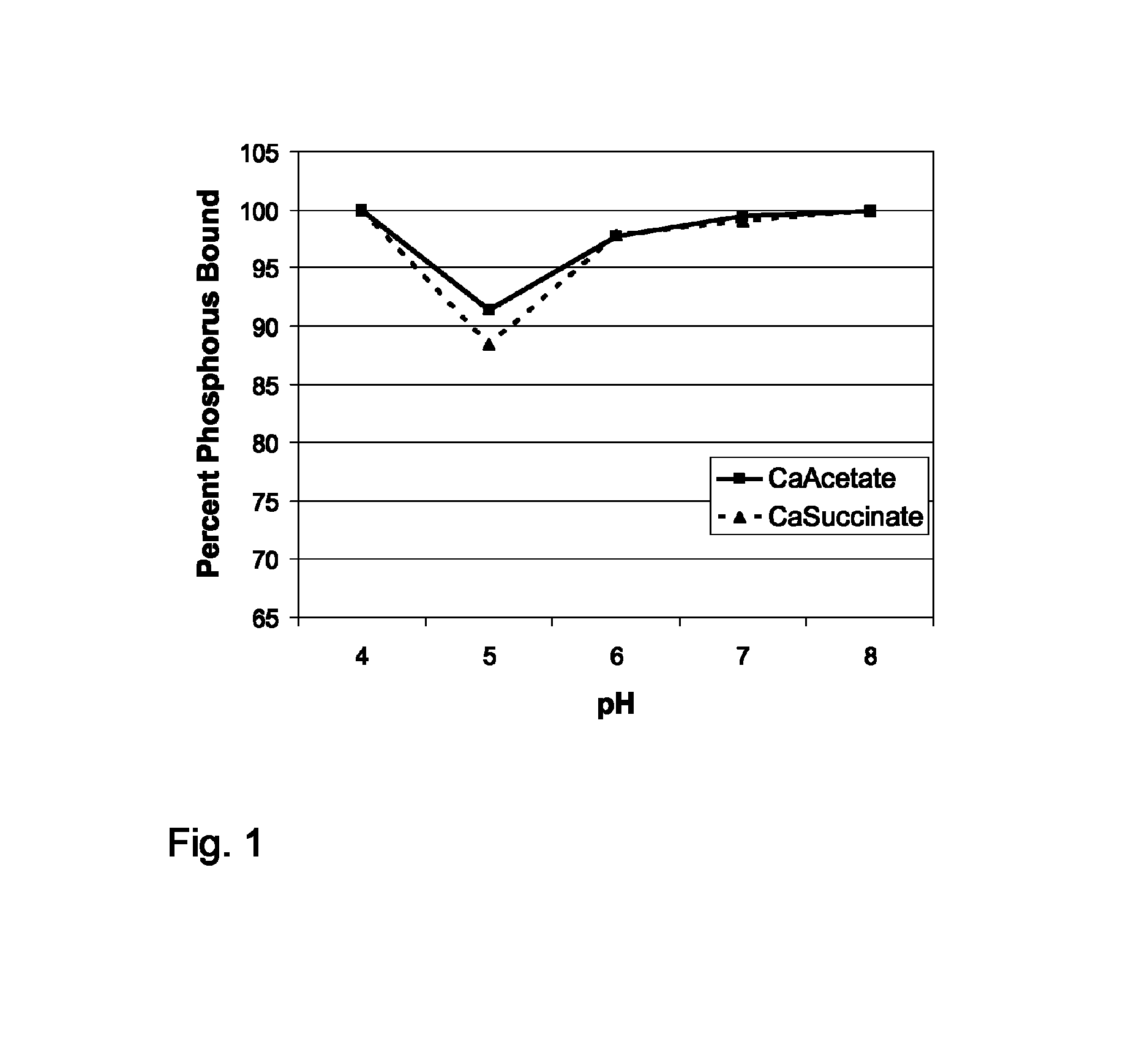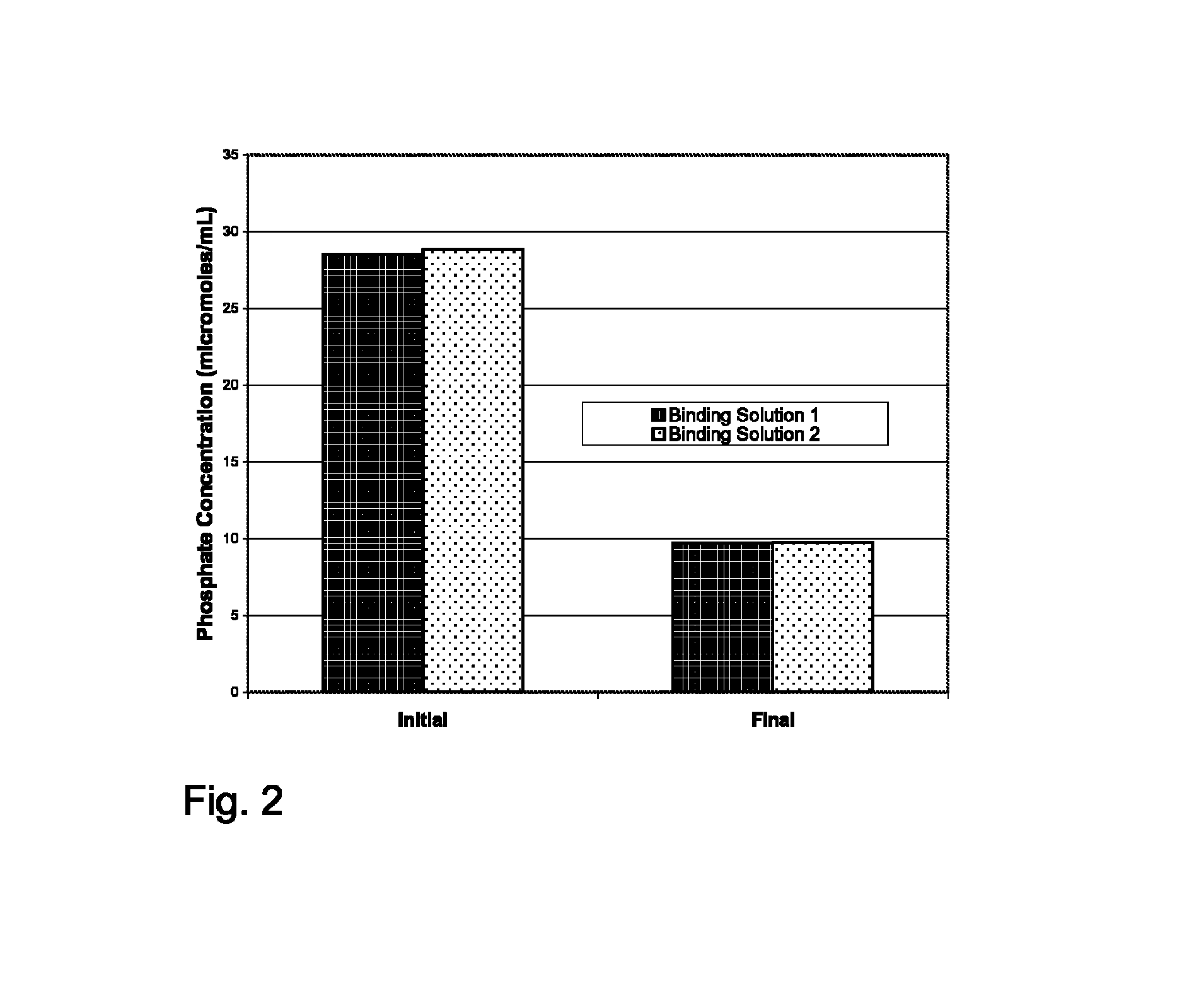Phosphorus binder composition for treatment of hyperphosphatemia
a phosphorus binder and hyperphosphatemia technology, applied in the field of oral pharmaceutical products, can solve the problems of increased serum phosphorus levels, dietary restriction, and inability to reduce the level of phosphorus in the blood by conventional dialysis, so as to prevent absorption of phosphate, reduce serum phosphorus concentration, and facilitate phosphate binding
- Summary
- Abstract
- Description
- Claims
- Application Information
AI Technical Summary
Benefits of technology
Problems solved by technology
Method used
Image
Examples
example 1
In Vitro Assessment of Phosphate Binding by a Calcium Succinate Composition of the Invention
[0073]Test Preparations:
[0074]Solutions of the test article (calcium succinate) and control article (calcium acetate) were prepared in deionized, purified water having 18 MΩ or greater resistance. The pH of each solution was adjusted to the desired value by the addition of concentrated hydrochloric acid or sodium hydroxide, as appropriate.
[0075]Tests and Assays:
[0076]Calcium succinate was assayed as described in the U.S. Pharmacopeia by dissolving an accurately weighed sample in water containing hydrochloric acid, adding hydroxynapthol blue as an indicator, and titrating to a blue endpoint with edetate disodium solution. An HPLC method with conductivity detection was developed and validated for use in the determination of succinate, acetate and phosphate. The separation was performed on a Dionex AS11 Cation-Exchange HPLC column integrated with an Agilent Series 1100 HPLC system, and detection...
example 2
Phosphate Binding by Calcium Succinate / Stool Softener Compositions
[0082]Experimental Methods:
[0083]Experiments were completed in 0.1 M borate buffer. Sodium phosphate dibasic heptahydrate (Na2HPO4.7H2O; 762.12 mg, 2.84 mmol; equivalent to 357 mg of phosphate) was dissolved in 100 mL of 0.1 M borate buffer. One milliliter of the resulting solution was removed and diluted volumetrically to 50 mL with 100 μM KOH solution for determination of the initial phosphate concentration. Calcium succinate monohydrate (681.95 mg, 3.9 mmol Ca) was added as the solid to the stirred phosphate solution to provide “Binding Solution 1.” The pH of the resulting solution was determined as 6.26. After Binding Solution 1 was stirred at ambient temperature for 24 hours, 1 mL of the supernatant was removed, filtered, transferred to a 50-mL volumetric flask, and diluted to volume with 100 μM KOH solution for determination of the final phosphate concentration in Binding Solution 1. (A period of 24 hr was selec...
example 3
Phosphate Binding Effectiveness of Compositions of the Invention
[0086]Phosphate binding is a chemical reaction between a cation and a phosphorus-containing anion to provide an insoluble phosphate that cannot be absorbed from the gastrointestinal tract. The percentage effectiveness of a phosphate binder may be measured and expressed as the ratio of moles of phosphate-binding agent to moles of phosphate present in the medium multiplied by 100. Ideally, both the cation and the phosphorus-containing anion are in solution, since phosphate-binding is most effective under these conditions. In vivo, effective phosphate-binding by ionized calcium is in the range 90% to over 100%. For convenience, the effectiveness of phosphate-binding by a calcium salt may be measured in vitro by determining the ionized calcium released by dissolution of a unit dose of a formulation. Therefore, the effectiveness of phosphate binding by experimental formulations of compositions of the invention was determined...
PUM
| Property | Measurement | Unit |
|---|---|---|
| density | aaaaa | aaaaa |
| density | aaaaa | aaaaa |
| pH | aaaaa | aaaaa |
Abstract
Description
Claims
Application Information
 Login to View More
Login to View More - R&D
- Intellectual Property
- Life Sciences
- Materials
- Tech Scout
- Unparalleled Data Quality
- Higher Quality Content
- 60% Fewer Hallucinations
Browse by: Latest US Patents, China's latest patents, Technical Efficacy Thesaurus, Application Domain, Technology Topic, Popular Technical Reports.
© 2025 PatSnap. All rights reserved.Legal|Privacy policy|Modern Slavery Act Transparency Statement|Sitemap|About US| Contact US: help@patsnap.com


